TIMELINE FOR WOMEN’S ROLES IN THE CHURCH OF CHRIST, SCIENTIST
1821 (July 16): Mary Morse Baker was born to Mark and Abigail Baker in Bow, New Hampshire.
1843: Mary Baker married George Washington Glover, who died in 1844. They had one son in 1844 named George W. Glover.
1853: She married Daniel Patterson.
1866 (February 4): Mary Patterson slipped on ice in Lynn, Massachusetts on February 1, and was seriously injured. Three days later, while reading about Jesus’ healing ministry in the Gospels, she was healed. She later cited this as the date she discovered Christian Science, as the result of her healing through prayer of injuries from a serious accident.
1866 (March): Her husband Daniel Patterson deserted her. They divorced in 1873.
1867: Mary Patterson began teaching about her discoveries, as well as maintaining an active healing practice.
1875 (October 30): Now active as a spiritual healer and teacher in Lynn, Massachusetts, she published the first edition of her book Science and Health.
1876 (July 4): She established the first Christian Science organization, the Christian Scientist Association, a small group of her students, a mix of both men and women.
1877 (January 1): She married Asa Gilbert Eddy. He passed away in 1882.
1879 (April 12): The Christian Scientist Association voted to found a church. The charter for the first Christian Science church, the Church of Christ (Scientist), in Boston, was granted by the Commonwealth of Massachusetts in August. Mary Baker Eddy served as pastor.
1881 (January 31): The Massachusetts Metaphysical College was chartered in Boston. Eddy served as its only President and taught classes there in Christian Science over the next eight years.
1881 (November 9): Eddy was ordained Pastor of the Boston church. While women served as pastors in other Christian Science churches, aside from Eddy only men served in this role in Boston at this time.
1883 (April 14): The Journal of Christian Science began publication, eventually becoming a monthly periodical that included articles on religious themes, as well as listings of both men and women as Christian Science healers, teachers, and nurses. Eddy served as the magazine’s first editor.
1889 (May 28): Eddy resigned the pastorate of the Boston church.
1890 (January): The Christian Science Quarterly began publishing Bible lessons. Originally intended for study and Sunday School classes, they later became “lesson-sermons” for reading in church services.
1892 (September): The Boston church was reorganized, and the Christian Science Board of Directors was established to transact the business of the church. The evolving system of membership allowed for both membership in the Boston church (The Mother Church) as well as in a branch church anywhere in the world.
1894 (December): Mary Baker Eddy named the Holy Bible and Science and Health the pastor of the Boston church.
1895 (January 6): The newly completed original Mother Church building in Boston was dedicated. A large extension church building was added in 1906.
1895 (April): Eddy named the Bible and Science and Health Pastor for all churches of the denomination.
1895 (April 23): Eddy was given the title “Pastor Emeritus” by the Boston church’s board of directors.
1895 (September 10): The first edition of the Church Manual was published, containing bylaws for the church, including a bylaw which specified that a male and a female would be appointed as Readers in the Boston church.
1898 (January): The Christian Science Board of Lectureship was established. The majority of lecturers during Eddy’s lifetime were men, though two women were appointed as lecturers in 1898.
1898 (September): At Eddy’s request, The Christian Science Publishing Society began publication of the Christian Science Sentinel, a weekly devoted to religious articles and testimonials of healing.
1903 (February): Originally comprised of four members, the Christian Science Board of Directors was expanded to five members. All were male until 1919.
1903 (April): The Herald of Christian Science, a non-English periodical, was first published. As of 2022, the publication was published in fourteen languages.
1908 (January 26): Eddy moved from Concord, New Hampshire, to Chestnut Hill, Massachusetts, near Boston.
1908 (November 25): The Christian Science Monitor was first published. As of 2022, the paper had been awarded seven Pulitzer Prizes and more than a dozen Overseas Press Club awards.
1910 (December 3): Mary Baker Eddy died in Chestnut Hill, aged eighty-nine years.
1913: Laura E. Sargent (a student of Eddy) became the first woman other than Eddy to teach the Church’s Normal class, training Christian Science practitioners to be teachers.
1919: Annie Macmillan Knott (an Eddy student) became the first woman to serve as a member of the Christian Science Board of Directors.
1927: Ella W. Hoag (an Eddy student) became the first woman to serve as President of The Mother Church. This annual appointment was largely an honorific.
1935: Margaret Murney Glenn Matters became the first woman to serve as chairman of the Christian Science Board of Lectureship.
1959: Helen Wood Bauman was appointed editor of Christian Science religious periodicals, the first woman in this position since 1892.
1977: Grace Channell Wasson became the first woman appointed to the First Reader role. Previously, only men had held that position at the Boston church in three-year terms.
1983: Katherine Fanning was appointed editor of The Christian Science Monitor. She was the first woman to head the newspaper, although women had worked as reporters and editors since its founding.
1988: It was in this year that as many as two women served simultaneously as Directors for the first time. In 2001, three women served simultaneously as Directors for the first time.
2021: Women accounted for nearly sixty percent of the denomination’s public lecturers.
HISTORY OF WOMEN IN THE CHURCH OF CHRIST, SCIENTIST
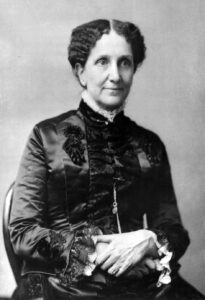
The history of women in The Church of Christ, Scientist naturally begins with its founder, Mary Baker Eddy (1821–1910), who led the movement until her death. [Image at right] Born in New Hampshire, Mary Baker grew up in a large family and received a modest education, while regularly battling various health issues. She was married in 1843. Her husband died in 1844, shortly before their son, George W. Glover, was born. She married Daniel Patterson in 1853, who deserted her in 1866; they divorced in 1873. She married Asa Gilbert Eddy in 1877, and thereafter became known as Mary Baker Eddy. It was in 1866, after a fall on an icy street in Lynn, Massachusetts, that she received what she later felt was a divine revelation that brought healing of her injuries while reading about the healing ministry of Jesus Christ in the Gospels. She felt that the revelation was not some kind of singular miracle, but an indication of divine laws governing humanity and the universe, a science that could be discovered and taught to others. She became a healer and teacher and published the first edition of her book Science and Health in 1875. The Christian Scientist Association was founded in 1876, attracting both women and men.
The Church of Christ, Scientist was founded in 1879, and, with a reorganization in 1892, it came to have a basic structure that remains in place today. The Christian Science Board of Directors transacts church business. The Christian Science Publishing Society (governed by three trustees) directs the denomination’s publications, including its famed daily newspaper, The Christian Science Monitor. Christian Scientists 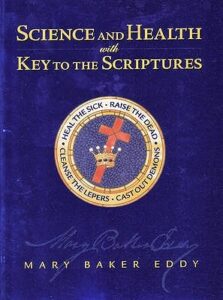 typically belong to the Boston church (formally known as The First Church of Christ, Scientist, and also known as The Mother Church), as well as a local “branch” church. Local churches are found all over the world. The Christian Bible and Science and Health serve as pastor for all churches. [Image at right] Eddy’s book has been translated into seventeen languages as well as Braille.
typically belong to the Boston church (formally known as The First Church of Christ, Scientist, and also known as The Mother Church), as well as a local “branch” church. Local churches are found all over the world. The Christian Bible and Science and Health serve as pastor for all churches. [Image at right] Eddy’s book has been translated into seventeen languages as well as Braille.
There have been times when the denomination’s leadership has been dominated by men. Christian Science historian Jean McDonald observed that “women scholars have generally theorized that Eddy and other women of the period gravitated toward Christian Science, not for its theological worth but for its personal utility, because it satisfied their needs for status and power in a male-dominated society that largely closed off other avenues of achievement” (McDonald 1986:89). But McDonald does not explore whether Christian Science actually provided this status and power. An examination of historical data presents a more complex picture, with men tending to obtain leadership roles at Boston headquarters, as well as in branch churches in many large cities and metropolitan regions. Yet women did succeed in finding leadership positions in Christian Science churches in some large cities (such as New York City, for example) and in many smaller, less prestigious localities.
Despite the difficulties in traversing some of the Christian Science “avenues of achievement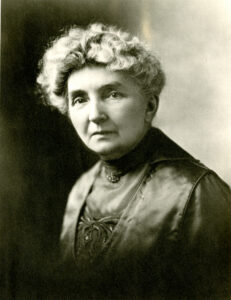 ,” there were women who were able to face this disparity, becoming public faces for the movement as well as making things happen. In 1913, Laura E. Sargent (1858–1915), who had studied under Eddy and served as her companion for a number of years, became the first woman to teach in the Church’s Board of Education, training Christian Science practitioners (healers who advertise their services) to be teachers.
,” there were women who were able to face this disparity, becoming public faces for the movement as well as making things happen. In 1913, Laura E. Sargent (1858–1915), who had studied under Eddy and served as her companion for a number of years, became the first woman to teach in the Church’s Board of Education, training Christian Science practitioners (healers who advertise their services) to be teachers.
In 1919, Annie Macmillan Knott (1850–1941), a Scottish immigrant, rose to the top ranks in the early church organization, serving as the first woman on the Christian Science Board of Directors, an office of considerable authority and significance within the denomination. [Image at right] This was, however, nearly a decade after Eddy’s passing. Knott’s path to the directorship was hardly an easy one. She began practicing Christian Science in the 1880s as a single mother in Detroit, Michigan. She became a church leader in Detroit, serving as a Christian Science healer, teacher, and preacher. She moved to Boston in 1903, to serve as an associate editor for Christian Science 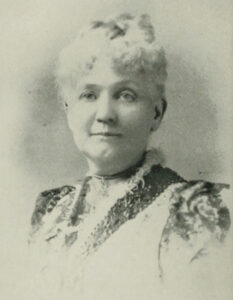 publications; the editor-in-chief was a man.
publications; the editor-in-chief was a man.
Mary Baker Eddy had recognized Knott’s promise five years earlier, in 1898, when she made the decision to appoint two women to serve with the five men she had already appointed as Christian Science lecturers. Knott and Sue Harper Mims (1842–1913) [Image at right] were Eddy’s choices. The Board of Lectureship had been established just months earlier as a way to reach those unacquainted with Christian Science via public talks, an arena in which women were becoming more accepted. Knott later recalled that at first she received few calls to lecture, and mentioned this in a conversation with Eddy. The church leader responded that Knott must “rise to the altitude of true womanhood, and then the whole world will want you. . . .” Knott soon found greater success in the lecture work (Knott 1934:42).
In 1935, Margaret Murney Glenn Matters (1887–1965), who had been a powerful force as chairman of the committee revising the Christian Science Hymnal, became the first woman to serve as chair of the 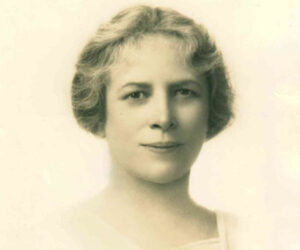 Christian Science Board of Lectureship. [Image at right] Glenn had also served as a Second Reader in church services in Boston. It was not until 1977 that Grace Channell Wasson (1907–1978) became the first woman appointed to the First Reader role, leading the weekly church services. Previously, only men had held that three-year position at the Boston headquarters.
Christian Science Board of Lectureship. [Image at right] Glenn had also served as a Second Reader in church services in Boston. It was not until 1977 that Grace Channell Wasson (1907–1978) became the first woman appointed to the First Reader role, leading the weekly church services. Previously, only men had held that three-year position at the Boston headquarters.
Women were also serving in leadership roles outside of Boston. Some of the better known figures in the movement’s early years (late nineteenth and early twentieth centuries) were Sue Ella Bradshaw (San Francisco), Mary M. W. Adams and Kate D. Kimball (Chicago; Kimball’s husband, Edward A. Kimball, was also a Christian Science leader in the city), E. Blanche Ward and Lady Victoria Murray (London and Manchester, England), and Bertha Günther-Peterson and Frances Thurber Seal (Germany; Seal, however, was an American). They worked as healers, teachers, lecturers, and responded to criticisms of Christian Science in the press.
Women’s advancement at headquarters came more incrementally. It was not until the 1950s that a number of women were holding supervisory positions in Boston, and women in senior management roles were quite rare until the late 1960s. Equal representation in management positions has become the norm in the half century since.
DOCTRINES/BELIEFS CONCERNING WOMEN’S ROLES
Mary Baker Eddy regarded men and women as equals in society and in leading the Christian Science movement.
Let it not be heard in Boston that woman, “last at the cross and first at the sepulchre,” has no rights which man is bound to respect. In natural law and in religion the right of woman to fill the highest measure of enlightened understanding and the highest places in government, is inalienable, and these rights are ably vindicated by the noblest of both sexes. This is woman’s hour, with all its sweet amenities and its moral and religious reforms (Eddy 1887:57).
In 1904, Eddy stated firmly:
The Magna Charta of Christian Science means much, multum in parvo, — all-in-one and one-in-all. It stands for the inalienable, universal rights of men. Essentially democratic, its government is administered by the common consent of the governed, wherein and whereby man governed by his creator is self-governed. The church is the mouthpiece of Christian Science, — its law and gospel are according to Christ Jesus; its rules are health, holiness, and immortality, — equal rights and privileges, equality of the sexes, rotation in office (Eddy 1914:246–47, punctuation as in original).
Why do Eddy’s statements give strong support for the equality of the sexes, while the administration of her religious denomination was largely relegated to men? Eddy was aware of this, as her essay “Man and Woman” (not published in her lifetime) makes clear. She wrote that she had “given the preponderance to the masculine element in my organizations for carrying out the functions of Christian Science.” However, she didn’t really explain why, although she may be hinting that this was all she could do given the social norms of the day and the capacities of her followers:
If at any period the reflection of the masculinity of God seems more apparent and desirable to the human senses than the reflection of His femininity, it is because the human perception, apprehension, and understanding have not kept pace with the Divine Love and order that characterize the period which manifests the dual nature of God, coupled with his trinity and the equality of man and woman (Eddy n.d.).
Theological statements tend to focus on the fact that men or women cannot be relegated to certain roles. Ella W. Hoag (1854–1928), an Eddy student, became in 1927 the first woman to serve as President of The Mother Church in Boston. In 1919, as the individual states were ratifying the Nineteenth Amendment to the United States Constitution, Hoag reflected in an editorial titled “Equal Suffrage”:
Because Christian Science teaches that all good is the equal inheritance of all of God’s children, it does not in any way relieve anyone from the responsibility of proving this for himself. Each individual must at some time not only prove that all good is for him as the image and likeness of God, but he must also come to understand that all good is equally for every other child of God. The practical application to-day of this truth to the subject of “equal rights for women,” if approached in obedience to the teachings of Christian Science, may do much to liberate the world from all its beliefs in inequality. . . . To give the “vote” to women will do comparatively little for them and for the world unless men perceive and relinquish the selfish, egotistical belief—which as a class they are indulging—that at least a degree of superior intelligence has been bestowed upon them. (Hoag 1919:365–66).
ORGANIZATIONAL ROLES
Although The Church of Christ, Scientist, was founded by a woman, advancement was rarely easy for women in its early days, or even later. But as Christian Science became more widely known in the late nineteenth century, with branch churches founded throughout the United States and beyond, a structure developed that included two paths for women. At the headquarters of the movement, centered then (as now) at The Mother Church in Boston, Massachusetts, leadership opportunities were somewhat limited for women. Yet in the churches throughout the global “field,” ranging from tiny Christian Science societies to large and impressive urban churches, leadership roles were far more available for women. Scholar and Christian Scientist Stephen Gottschalk describes the state of affairs in his 2006 study Rolling Away the Stone: Mary Baker Eddy’s Challenge to Materialism:
In part, Eddy appointed men to visible posts in the movement, not because she saw them as having superior capacities, but because they were more acceptable to society at the time than women would have been in the same roles. . . . If Eddy looked to men as the public face of Christian Science, she largely looked to women to make things happen—that is, to build the movement from the ground up. This they did in considerable numbers, so that outside Eddy’s own labors, the work of women was probably the single most important element in the spread of the Christian Science movement in the period before her death. Their labors as healers, teachers, and organizers of churches accounted in large measure for the development of Christian Science, for example, in Minneapolis, New York, Spokane, San Francisco, southern Los Angeles, Detroit, and also in such European cities as London, Hanover, and Berlin (Gottschalk 2006:185).
Readers play a significant role in a global church that has no clergy. Sermons are compiled from the two texts that form the “Pastor” of the church: the Bible and Eddy’s Science and Health with Key to the Scriptures. The Sunday sermons, found in the Christian Science Quarterly published by The Christian Science Publishing Society, are read by two Readers (First Reader, Science and Health; Second Reader, Bible). The First Reader also is responsible for conducting the services. At Wednesday meetings, First Readers compile their own readings on self-chosen topics from Science and Health and the Bible. Readers are lay positions, elected by the congregations in the branch churches. At The Mother Church, Church headquarters, the Christian Science Board of Directors appoints Readers for the Boston services every three years.
Christian Science practitioners are not clergy, but are found worldwide, and play an important role in the church. To be listed as a practitioner in the church’s monthly periodical, The Christian Science Journal, an individual must devote his or her full time to helping individuals through prayer. (Eddy’s Science and Health is the best source for information on the Christian Science approach to spiritual healing, particularly the chapter “Christian Science Practice.”) Practitioners are self-employed, and fees and payment are determined by the individual practitioner. Practitioners, like many Christian Scientists, have taken Primary class instruction, a two-week course of study that teaches students how to heal themselves and others. Some practitioners eventually take Normal class instruction and become teachers of Primary classes.
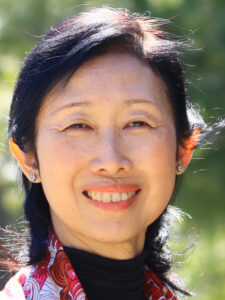
A quick survey of the listings of Christian Science practitioners (healers and teachers of classes in healing) in the monthly Christian Science Journal gives a sense of the situation: women could attain leadership roles outside of Boston. [Image at right] In 1900, San Francisco’s listings of practitioners were sixty percent women; Chicago’s listings were eighty-three percent women; and London’s listings were eighty-one percent women. In 1950, San Francisco’s practitioners were nearly eighty percent women; Chicago’s practitioners were eighty-one percent women and London’s practitioners had increased to 85.5 percent women. In 2000, San Francisco’s Christian Science practitioners were 65.5 percent women; Chicago’s practitioners were close to eighty percent women, and London’s practitioners were eighty-four percent women.
ISSUES/CHALLENGES FACING WOMEN
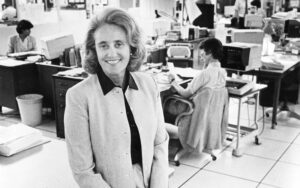
Today, the roles women play in The Church of Christ, Scientist are, at last, many and varied, both at Boston headquarters and in branch churches worldwide. Is this a reflection of a change in Christian Science attitudes, or a reflection of changes in society? It is likely a little of both, but such progress is welcome, even as it is ongoing. In 1959, Helen Wood Bauman (1895–1985) was appointed the first woman editor of the Christian Science periodicals since 1892. Katherine Fanning (1927–2000), [Image at right] the first woman editor of the daily newspaper founded by Eddy, the Pulitzer Prize winning The Christian Science Monitor, was not appointed until 1983. In 1988, for the first time, two women were simultaneously serving as members of the Mother Church board of directors, a sign that the “highest places in government” in the denomination were becoming more and more accessible to women.
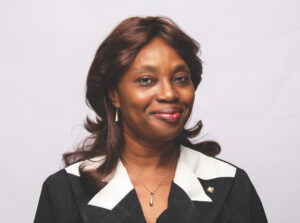
Currently in 2022, women serve in a variety of leadership roles at church headquarters in Boston. For example, Barbara Fife and Mary Alice Rose are members of the board of directors; the First Reader conducting church services is Mojisola George; (Image at right) Ethel Baker serves as editor of The Christian Science Publishing Society’s religious periodicals; the President of the church is Mimi Oka; and The Christian Science Monitor’s managing editor is Amelia Newcomb.
Another important advance for The Church of Christ, Scientist, is its increasingly international as well as racially diverse presence. The November 2021 admission of church members included applications received from a number of countries: Angola, Australia, Brazil, Canada, Cuba, Democratic Republic of the Congo, Germany, India, Italy, Kenya, Mexico, Nigeria, Pakistan, Peru, Republic of the Congo, Rwanda, Sierra Leone, South Africa, Spain, Togo, United Kingdom, United States, Uruguay, Zambia, and Zimbabwe. Women are playing an important role in leading the internationalization of the denomination.
SIGNIFICANCE TO THE STUDY OF WOMEN IN RELIGIONS
Mary Baker Eddy founded a religion. This is significant, for even today, nearly 150 years after this founding, there are not many religions that identify women as among their founders. Eddy also led the church and was deeply involved in its government from the time of its founding until her passing three decades later. The Church of Christ, Scientist, while not intended by Eddy to be a women’s religion, has attracted a large number of women into its ranks. Its theology emphasizes the spirituality and the equality of men and women, without segregation or subordination of women, or men. This strong sense of equality precludes the placement of either sex on a pedestal. By ruling out comparisons that define the superiority (or inferiority) of maleness or femaleness, Christian Science has over time made it more possible for women to attain important positions within the denomination, and for a fairly new church (which will be 150 years old in 2029) this progress will surely continue to become evident.
IMAGES
Image #1: Photograph of Mary Baker Eddy taken in the 1880s. Library of Congress. Wikimedia Commons.
Image #2: Cover of Mary Baker Eddy’s book, Science and Health with Key to the Scriptures. Courtesy of The First Church of Christ, Scientist.
Image #3: Annie Macmillan Knott, the first woman to serve on the Christian Science Board of Directors. P01082. Courtesy of The Mary Baker Eddy Library.
Image #4: Photograph of Sue Harper Mims in the book edited by Frances E. Willard, A Woman of the Century: Fourteen Hundred-seventy Biographical Sketches Accompanied by Portraits of Leading Women in All Walks of Life (1893). Wikimedia Commons.
Image #5: Portrait of Margaret Murney Glenn Matters, circa 1940. Bachrach Studios. Courtesy of The Mary Baker Eddy Library.
Image #6: Fujiko Signs, of Tokyo, Japan, is a Christian Science practitioner, teacher, and lecturer. Signs is also `serving as Committee on Publication for Japan, responding to public statements on Christian Science. Courtesy of The First Church of Christ, Scientist.
Image #7: Katherine Fanning, 1983. Photography by Linda Payne. The Christian Science Monitor. Courtesy of The Mary Baker Eddy Library.
Image #8: Mojisola Anjorin Solanke George, a Christian Science practitioner and teacher based in Lagos, Nigeria, is currently serving as First Reader of The Mother Church in Boston, and has formerly served as a Christian Science lecturer.
REFERENCES
Eddy, Mary Baker. 1914. The First Church of Christ, Scientist, and Miscellany. Boston, MA: Allison V. Stewart.
Eddy, Mary Baker. 1887. Christian Science: No and Yes. Boston, MA: The Author.
Eddy, Mary Baker. 1895. Church Manual of The First Church of Christ, Scientist, in Boston, Massachusetts. First Edition. Boston, MA: The Christian Science Publishing Society.
Eddy, Mary Baker. n.d. “Man and Woman.” The Mary Baker Eddy Library, A10142B.
Gottschalk, Stephen. 2006. Rolling Away the Stone: Mary Baker Eddy’s Challenge to Materialism. Bloomington and Indianapolis: Indiana University Press.
Hoag, Ella W. 1919. “Equal Suffrage.” The Christian Science Journal 37: 364–66.
Knott, Annie M. 1934. Reminiscence, archival collections of the Mary Baker Eddy Library.
McDonald, Jean A. 1986. “Mary Baker Eddy and the Nineteenth-Century ‘Public’ Woman: A Feminist Reappraisal.” Journal of Feminist Studies in Religion 2: 89–111.
Voorhees, Amy B. 2021. A New Christian Identity: Christian Science Origins and Experience in American Culture. Chapel Hill: University of North Carolina Press.
SUPPLEMENTARY RESOURCES
The Mary Baker Eddy Library (www.mbelibrary.org) regularly publishes articles on its website relating to women Christian Scientists. The series is titled “Women of History.” The site also has a downloadable chronology of church founder Mary Baker Eddy’s life. This chronology is fully annotated, providing references to many primary and secondary sources. PDFs of The Christian Science Journal listings of practitioners from 1883 to the present day are available on The Christian Science Publishing Society subscription website JSH-Online (https://jsh.christianscience.com/).
Christian Science Journal listings are available on The Christian Science Publishing Society website JSH-Online https://jsh.christianscience.com/.
Eddy, Mary Baker. 1925. Prose Works Other than Science and Health with Key to the Scriptures. Boston, MA: The First Church of Christ, Scientist.
Eddy, Mary Baker. 1910. Manual of The Mother Church, Eighty-Ninth Edition. Boston, MA: The First Church of Christ, Scientist.
Eddy, Mary Baker. 1910. Science and Health with Key to the Scriptures. Boston, MA: The First Church of Christ, Scientist.
Gill, Gillian. 1998. Mary Baker Eddy. Reading, MA: Perseus Books.
Voorhees, Amy B. 2021. A New Christian Identity: Christian Science Origins and Experience in American Culture. Chapel Hill: The University of North Carolina Press.
Publication Date:
1 May 2022
2021: Women accounted for nearly 60 percent of the denomination’s public lecturers.
